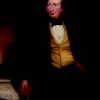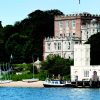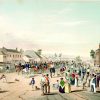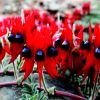At first inclination Captain Charles Sturt seems an obvious choice for immortality in the streets of Adelaide. After all, he was the first European to navigate the entire length of the Murray River (1829–30), noting the possibilities for future European settlement in the ranges east of the embouchure to the Southern Ocean.
Like Matthew Flinders and Sir John Franklin before him, Sturt’s exploration in and around the vast Australian continent was significant in determining where a new settlement might be founded. The Street Naming Committee which met in Adelaide on 23 May 1837 was acutely aware of this.
As the committee members sat on wooden boxes in a rudimentary hut somewhere near the site of Holy Trinity Church on North Terrace, they were appropriately deferential to those who had gone before. The Street Naming Committee worked radially from the centre of the Adelaide plan, first naming the two most important members of the royal family and a handful of the most venerated and influential proponents of the scheme. Only then did attention turn to those who had ventured to what was then, to most Englishmen, ‘earth’s remotest strand’. Matthew Flinders and Sir John Franklin, his step-cousin, were paired on the northern side of Victoria Square. Sturt was probably next and given the first street beyond the south-west corner of the central square.
Captain Charles Sturt has been eulogised in South Australia for more than 175 years. In the minds of earlier generations of school children he reached heroic status of monumental proportions. His statue still retains a commanding position in Victoria Square, but as the world becomes a smaller, more intimate space and South Australians begin to lose their sense of geographic isolation his place in history is beginning to fade. He barely rates a mention in educational institutions anymore. Moreover, some writers have re-evaluated Sturt, the man, and found him wanting in some ways.
Sturt’s role in the foundation of South Australia was not pivotal. Indeed, it is better described as marginal and was more circumstantial than intentional, demanding that he be given second-order status when compared with most of the others named in Adelaide’s streets. His feats as an inland explorer do have national significance, but his political affiliation places him in the minority and at odds with the sentiments of almost all who have been named in the Adelaide streets. Although he visited with the South Australian Association in 1834, providing insight into a possible site for the settlement, his political sentiments not long afterwards suggest he was an encrusted Tory.
Charles Napier Sturt was born at Chunar-Ghur, near Bengal in India, on 28 April 1795, the third of thirteen children and the eldest of eight surviving sons. His father was a puisne judge for the East India Company in Bengal, the world’s dominant trading monopoly of the eighteenth century and arguably the defacto government of India at that time.
In 1799, aged 4, Charles was sent to England with his older sister to be raised by a widowed aunt. He wasn’t to see his parents again for another ten years. By all accounts his childhood in England was a happy one, for he was introduced to a world of status and privilege and spent many hours on holiday at his grandfather’s estate at Branksea Castle, roaming in its woods and playing on the lea side of Brownsea Island in Poole Harbour.
Charles Sturt was educated firstly at Astbury in Cheshire and then at Harrow. By 1812 his father had fallen into financial difficulty and Charles was sent to a private tutor to finish his education. Expectations that he would attend Cambridge University never materialised, nor did his parent’s hope that he would join his uncle’s regiment at Weymouth. They simply didn’t have the money. Fortunately, Charles Sturt’s Aunt Mary knew the Prince Regent and was able to intercede with an obsequious appeal on his behalf. On 9 September 1813 Sturt was gazetted as a member of the 39th Regiment and began what was to become a twenty-year career as an officer.
Unfortunately, Sturt’s military life did not unfold as he had hoped. Nor did his expectation of a genteel position in society. After repeated applications for promotion he was finally elevated to Captain in 1825. Towards the end of 1826 he was sent in charge of a detachment of the 39th to escort the convict ship HMS Mariner to the settlement in Sydney. Sturt arrived in Sydney with 158 surviving male convicts on 23 May 1827, precisely ten years to the day before he was named in Adelaide’s streets.
Sturt did not physically set foot on the Adelaide Plains until several years later when he drove a team of cattle and sheep westward to the new markets in Adelaide in 1838. On his return to Sydney, Sturt’s exploration report to Governor Darling of Australia’s inland river system lay gathering dust for a few months before being dispatched to the Colonial Office. The confluence of events at this point is serendipitous because it coincided exactly with the release of Wakefield’s theories on colonisation and the formation of the National Colonization Society by Edward Gibbon Wakefield, Robert Gouger, Colonel Robert Torrens and others.
Towards the latter half of 1831 Lord Goderich, the Colonial Secretary, finally received Sturt’s official report. In a reply to Governor Bourke, Darling’s replacement in New South Wales (NSW), he had inadvertently for the first time thrown light on the very piece of land on which Colonel Light was later to plant the city of Adelaide.
Back in London, Sturt set about writing his Two Expeditions into the Interior of Southern Australia which was published in 1833. He let his ideas about a possible site for a proposed colony be known to both the Colonial Office and the South Australian Association but reserved judgement on the economic viability of Wakefield’s plan. He sought and received dispensation from the army on the pretext that his eyesight had suffered irreparable damage and was pensioned out of the army on medical grounds on £100 a year.
With a clear intention of cashing in his annuity for a land grant in NSW and prompted by utilitarian advice rather than passion, he married 33-year-old Charlotte Christiana Greene in September 1834 at St Saviour’s in Southwark.
Charles Sturt’s pastoral enterprises in NSW could hardly be described as successful, for on his return to Australia the country was gripped by drought and cattle and sheep prices had collapsed. His expectation of establishing a grand mansion with manicured gardens, strutting peacocks imported from family in India, and avenues of trees never materialised. Instead he was eventually forced to overland cattle and sheep to Adelaide in the hope of recouping a return. The livestock arrived in Adelaide in such poor condition that his unenviable economic position was further eroded. Nevertheless, the young colony paid tribute to him with a grand dinner, a gesture which massaged his ego, and induced him to consider uprooting his family in favour of South Australia.
Charles and Charlotte had four children: three boys and a girl. In 1840 Sturt began construction of his new family home on an eighty-acre section near the coast, the River Torrens and the area then known as the Reedbeds. This substantial home, by early South Australian standards, remains today as a monument and museum to the Sturt family and was called Grange, after which the nearby beachside suburb was also named. In 1843 Charlotte gave birth to a fourth child, a girl they named Charlotte Eyre Sturt, who was known throughout her life as Missie.
In Adelaide, Sturt attempted to restart his life as a gentleman, but this time on the public purse and as a bureaucrat. At first he refused an offer to become Surveyor General because it came from the Acting Governor George Milner Stephen, preferring instead to wait for the imprimatur of Governor Hindmarsh’s appointed successor, namely Governor George Gawler. When Gawler arrived the offer was confirmed and Sturt took up the position on £600 a year. This was the highest level appointment he had thus far enjoyed and he was buoyed by the power and opportunities it provided.
As Surveyor General Sturt took a seat on the Legislative Council and contributed to all executive decisions in the colony. This pleased him and he began to think that his fortunes had changed for the better. As a result, he launched into some of the more noble activities in the colony, taking up the presidency of the Literary and Scientific Association and of the Mechanics’ Institute. However, he made one crucial mistake: on several occasions he privately ridiculed the logic which had driven Wakefield, Gouger and the other ideologues. His aloofness and lack of empathy for those he thought beneath him began to affect how he was viewed.
Nevertheless, Sturt was sworn in as a Justice of the Peace, became a trustee of Holy Trinity Church and was the first President of the South Australian Literary and Scientific Association, which met in the first Adelaide Mechanics’ Institute. As Surveyor General and despite his lack of formal qualifications, he surveyed the Encounter Bay area with the expressed purpose of confirming its unsuitability as a harbour. The rancour over the preferred site of Adelaide chosen by Colonel Light still bubbled below the surface and there needed to be closure on the issue. This survey in and around Victor Harbor vindicated Light’s decision.
His confidence was severely dented when Gawler’s decision to appoint him was overturned only months later, when the commissioners in London appointed Captain Edward Charles Frome instead. Sturt was personally affronted and demoted to Assistant Commissioner of Lands on a reduced salary of £500. He never blamed Gawler but did resent Torrens and the commissioners in London.
If moving to South Australia from NSW had been Sturt’s first great mistake, his obsequious and sycophantic appeal to Lord John Russell for the governorship of South Australia was his next and perhaps his greatest. Much to Sturt’s disappointment Captain Grey was anointed Governor instead, and from a cool but cordial start their relationship gradually descended into bitterness and acrimony.
To add insult to injury, under Grey, Sturt’s salary as both Assistant Commissioner of Lands and Registrar General was reduced to £400, and when the colony was at its lowest ebb financially in January 1843, his position as Assistant Commissioner was withdrawn.
In what some have thought to be a manic depressive response to repeated frustration within the colonial government, Sturt fell back on his obsession with exploration and the dream of an inland sea. Pointedly, his most significant advancement in life grew from the kudos following his Murray River exploits, and he still harboured a belief that a governorship awaited him if he could again do something momentous. In what proved to be a desperate and dangerous attempt to gain glory, and in a state of partial blindness, Sturt set out to unravel the mysteries of the great unknown in Central Australia.
The 1844 expedition to Central Australia didn’t meet with anything like the success of Sturt’s cruise down the Murray. He began to despair. There was no inland sea and as he trudged across the gibber plains of what was to be called the Sturt Stony Desert he was almost at the point of breaking.
Charles Sturt arrived back in Adelaide on 19 January 1846 suffering from exhaustion and scurvy. In his absence he had been appointed Colonial Secretary and he later became Colonial Treasurer. In 1847 he was honoured by the Royal Geographical Society in London with a Gold Medal and a fellowship. This paired very nicely with the fellowship he had been given by the Linnean Society in 1833, particularly as he had now discovered what was to become the floral emblem of South Australia, the Sturt Pea, or Clianthus formosus. He spent 1847 to 1849 in England publishing his Narrative of an Expedition into Central Australia and in March 1849 was presented to Queen Victoria at court by Earl Grey.
Back in Adelaide the South Australian Legislature awarded him a pension of £600 in 1851. Sturt left Adelaide permanently in 1853 and thereafter resided in Cheltenham, London, where he persisted with more futile requests to be made Governor in Victoria, Queensland and elsewhere. He died on 16 June 1869.








Comments